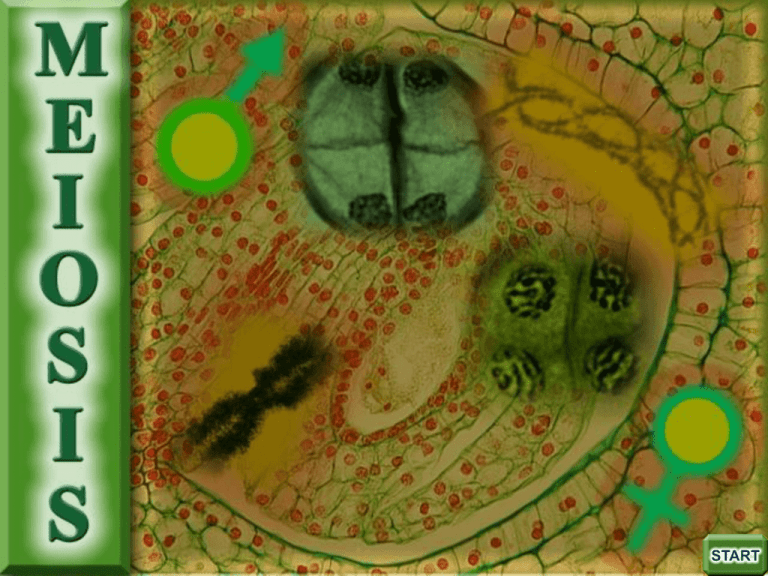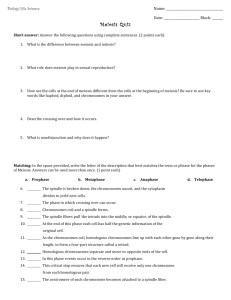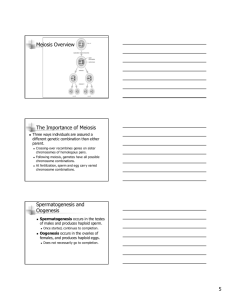
Meiosis is a form of cell division in which the diploid number (2N)
of chromosomes is reduced to the haploid number (N)
In preparation for meiosis during Interphase, DNA replicates
once following which there are two nuclear divisions
At the end of meiosis, a single diploid cell gives rise to four haploid
cells, each containing one member from each pair of
the original homologous chromosomes
In sexually reproducing organisms, meiosis occurs at some point in
the life cycle to ensure that haploid gametes are produced
The haploid gametes fuse at fertilisation and the diploid condition is
restored again in the zygote – meiosis is essential for ensuring that
the chromosome number does not double with each generation
Meiosis is a continuous process, but for convenience
of description is divided into the stages of:
Prophase
Metaphase
Anaphase
Telophase
Each of these stages occurs during Meiosis I and
again during Meiosis II
Meiosis is therefore a two-stage process although
DNA replicates only once during the cycle
The following description considers the process of
meiosis occurring in a diploid cell with two pairs of
chromosomes, i.e. where 2n = 4
During interphase, chromosomes
are present as granular material
called chromatin; DNA replicates
and new macromolecules and
organelles are manufactured in
preparation for cell division
Prophase I is the longest phase of
meiosis and begins with condensation
and spiralisation of the chromosomes;
the chromosomes thus shorten and become
visible as distinct threads in the nucleus
The bivalents become shorter and thicker
by further spiralisation and each
chromosome can now be seen to consist
of two chromatids held together at the centromere
Tetrad
Homologous chromosomes come to
lie close together in a process called
synapsis; the paired chromosomes
are called bivalents
The pairs of identical sister chromatids
are the result of DNA replication that
occurred during interphase; each group
of four chromatids is termed a tetrad
A pair of identical sister chromatids
resulting from the replication of DNA
during Interphase
A Pair of Homologous Chromosomes
Paternal member Maternal member
of pair
of pair
The four closely associated
chromatids, for each of the pairs
of homologous chromosomes,
form an arrangement
known as a tetrad
At this stage during meiosis
(prophase I), the non-sister
chromatids are so closely
associated that they become
intertwined forming positions
of overlap known as chiasmata
At these positions of chiasmata,
the non-sister chromatids break
and exchange sections of
genetic material in a process
known as crossing over
sister
chromatids
sister
chromatids
The exchange of genetic material between chromatids of
maternal and paternal origin is one source of the
genetic variation that results from meiosis
Chiasma formation
Crossing over and the
exchange of genetic material
Chiasmata and Crossing Over
The photograph below shows chiasmata formation between
non-sister chromatids from a pair of homologous chromosomes
Positions of chiasmata
The longer the chromosome, the greater the number
of chiasmata that are likely to form
Towards the end of
Prophase I, the nuclear
membrane breaks down
and spindle fibres form
across the cell
During Metaphase I the
chromosomes line up along
the equator of the spindle
in their homologous pairs
The orientation of each
pair of chromosomes on
the spindle is a random
event and this provides a
second source of the
genetic variation that
results from the
process of meiosis
During Anaphase I
spindle activity separates
the homologous pairs of
chromosomes
The homologous pairs of
chromosomes migrate to
opposite poles of the cell
During Telophase I, the spindle disintegrates and
nuclear membranes reform
In animal cells, the membrane constricts
down the middle of the cell and two
daughter cells are formed (cytokinesis)
Each daughter cell contains one
member from each pair of
homologous chromosomes
The two cells entering Prophase II of meiosis possess one member from each pair
of homologous chromosomes and are thus described as haploid cells
During Late Prophase II the nuclear membranes
disintegrate again and spindle fibres begin to form
The chromosomes (each consisting of two sister chromatids) line up
independently along the equator of the spindle
The purpose of Meiosis II is to separate the sister chromatids
and to distribute them into the four products of meiosis
During Anaphase II the centrioles replicate allowing
the chromatids to repel one another
Spindle activity pulls the chromatids to opposite poles
of the cell where they are now described as
chromosomes
In animal cells
there is
constriction
across the middle
Each cell then
divides into two
Four haploid daughter cells
result, each possessing one
member from each pair of
original chromosomes
Four, genetically different cells are produced as a result of meiosis
The four cells shown here are
the products of meiosis as it
occurs within the anthers of a
flowering plant
Each of these four haploid
daughter cells separate from
one another and develop
into the male gametes
(pollen grains) of the lily flower
The DNA content of cells varies during the meiotic cycle
During the pre-meiotic By the end of meiosis I At the end of
S Phase (interphase),
the DNA content is
meiosis II, the
DNA replicates and hence halved as homologous DNA content is
the DNA content doubles chromosomes separate half that of the
into different cells
original cell
Meiosis produces haploid cells in which the DNA content has been
halved with respect to the original diploid cell
During sexual reproduction, meiosis ensures that the
chromosome number of the gametes is halved prior to
fertilisation; without meiosis, doubling of chromosome
number would occur at each fertilisation
Meiosis is an important source of genetic variation through:
•
•
Chiasmata formation and crossing over
The random orientation of the homologous pairs of
chromosomes at Metaphase I and their subsequent distribution
into the divided cells (Independent Assortment)
Use the provided worksheet to make
comparisons between the processes of
meiosis and mitosis
Acknowledgements
Copyright © 2006 SSER Ltd. and its licensors.
All rights reserved. All graphics are for viewing purposes only.








